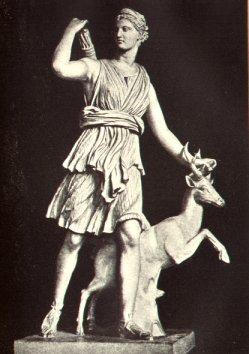
Diana
In Rome, Diana was not originally considered a local goddess; his first sanctuary was built on the Aventine, therefore, undoubtedly outside the primitive pomoerii, and Varro adds him to the list of gods, which, after founding, would introduce the Sabine Titus Tatius. However, it is not that far away. Her name, Diana undoubtedly Latin: derived from an adjective you say - found in Rome, associated with several divine names: Dyus Phidias (who may be none other than Jupiter; in any case, the god of oaths and lightning), Dea Dia (to whom the sacred tree of the Arvalez brothers was consecrated) - or on the substantial (?) diame meaning "heavenly space".
His most important cult, antecedent to the Aventine, is located in Arisia, in the sacred forest ( nemus , hence the name Diana nemorensis ), not far from the lake (mirror of the goddess), in the territory of d'Alb-la. -Longue, the former ruling city of the Latin League. The priest of the cult of Arisia bears the title of king king of the woods (in Rome, in the same way we talk about King of the Sacred, "King of Ceremonies"); his succession remains constantly open: whoever seeks to replace him must only kill him using a branch plucked from a certain tree in a sacred grove; in the early days, only slaves or poor people could take on this function. Diane d'Arisi is the goddess of reproductive functions and childbirth (during the excavations of Arisi, many images of male or female genitalia were found). In the forest of the goddess lives a nymph named Egeria (that is, "the end of pregnancy"): sacrifices are made to her in order to get an easy birth. The sanctuary does not depend directly on Alba: since it is federal, common to all Latin cities, it enjoys the privilege of extraterritoriality, the right of asylum; his presence, isolated on the territory of Albania, however justifies the superiority of Alban in the League. These different traits, combined with elements obtained in comparison with other Indo-European deities, allowed Georges Dumezil to see in Diana the goddess of heavenly space, sovereignty and its attribution, as well as the patroness of birth.
The Aventine cult in Rome is clearly copying the cult of Aricia; his position must coincide with Rome's assertion of his leading role in Lazio. The holiday (August 13) there is the same as that of Arisi. There is always fertility and superiority in Diana's attributes. Women worship him (on August 13, hair is combed in his honor); The legendary anecdote told by Livy says that the Sabine, hearing about the oracle, which ensures sovereignty to people, was the first to sacrifice a cow to Diana of Aventine, came to the temple for this purpose: the Roman priest, whom I sent, cleansed himself in the Tiber and hastened to bring the animal sacrificed at this time. We do not know when the Aventine cult originated. The second king of Rome, Numa,who is obviously no different from Egeria of Arica and who would have followed Diana to Rome; but these are all legends. Perhaps the same is the tradition reported by Dionysius of Halicarnassus, according to which the founder of the cult will be King Servius Tullius. As in others, August 13, on the anniversary of the temple, is also called the "holiday of the slaves" ( served), it could be a simple agreement between the name of the slave and the name of the king (for the same reasons, it was assumed that the latter was himself a slave); in fact, the dominance of Rome over the Latin League comes later. Conversely, the right of refuge, which Servius would establish in accordance with the same tradition, and which would then make the sanctuary a place of international trade, would be very well explained at the present time by other examples from the Mediterranean world; the protection this right of refuge afforded to the slaves could explain their connection to the goddess. It is also possible, if this tradition is well founded, that Diana, the goddess of the Aventine, like Ceres, was subsequently deprived by her of some of her functions; that it is also in origin connected with the plebs and that the immunity of the tribunes is a continuation of the refuge of his sanctuary. It was in the latter, in ~ 121, that the tribunes Gaius Gracchus would seek refuge; until the end of the Empire, peasants and merchants would refer to Diana as their protector. Was it influenced by the important cult of Diana on Mount Tifat, near Capua, in Campania (an early Hellenized region)? Did Diana discover very early on that she was assimilated with the influence of the important worship that was performed to Diana on Mount Tiphata, near Capua, in Campania (an early Hellenized region)? Did Diana discover very early on that she was assimilated with the influence of the important worship that was performed to Diana on Mount Tiphata, near Capua, in Campania (an early Hellenized region)? Diana discovered very early that she had assimilated withArtemis , Greek goddess: she receives virginity, a taste for hunting, communication with her brother Apollo, lunar attributes. After epidemics, starting in ~ 399, we choose a lectist, where Apollo and Latona, his mother, Hercules and Diana, Mercury and Neptune appear on three beds: Diana, who appears in this Etruscan-Greek rite, is obviously Artemis, who is guilty of epidemics of female deaths, as her brother is responsible for male deaths. During the time of the Empire, Diana Artemis benefited from the new meaning given by Augustus to the cult of Apollo: in about AD 17, the third day of the Secular Games is dedicated to Apollo Palatine and his sister Diana; the choral song composed for this occasion by Horace refers only to the Greek myths about the goddess.
Leave a Reply